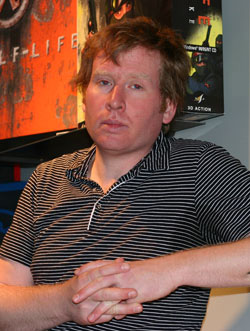User:Barnz/Tom Leonard
| Barnz/Tom Leonard | |
|---|---|

| |
| Biographical information | |
| Title(s) |
Various |
| Time period |
April 2002 – February 2013[1] |
Tom Leonard is a game developer who worked at Valve.
Contents
Biography[edit]
Tom has been working in the video game industry since 1995. He joined Valve in April of 2002. He had previously worked at Looking Glass Studios.
Work[edit]
Tom was responsible for core artificial intelligence in Half-Life 2 and episodes.
Half-Life 2[edit]
Tom served as a senior developer on Half-Life 2. He worked on artificial intelligence and behavior systems. He built a framework where multiple programmers could safely construct locally appropriate behaviors without interfering with each other.
He was the design and technology lead on chapters Route Kanal, "We Don't Go To Ravenholm...", Anticitizen One, and Follow Freeman. This role comprised of level design, gameplay coding, scheduling, planning, and managing the "C17 Cabal". He worked closely with the Cabal to plan, build, test, and tune over 1/3 of the game. He led the final playtesting push, managing coverage, and bug tracking.
He wrote the parts of the artificial intelligence for the the Citizens, the Zombies, the Strider, the Civil Protection, and the Combine Soldiers. He designed, implemented, and tuned the first Strider battle.
He built level design tools for crafting experiences. He was also responsible for core Source engine technologies, such as including the memory allocation system, save/restore system, core threading tools, and profiling tools.
Half-Life 2 (Xbox port)[edit]
Tom led the effort to get Half-Life 2 on Xbox, including CPU optimization, memory optimization, and custom allocators. He built the asynchronous file system for Source, contributed to redesign of portions of the game that were outside the capacity of the console, and merged code eight months divergent back into Valve's mainline after ship.
Half-Life 2: Episode Two[edit]
Tom single-handedly refactored and rewrote much of the guts of the Source engine for multicore architectures. He built the engine's "job thread" system, introduced lock-free data structures and algorithms, including deep rewrite of the core allocator.
He co-designed the ambush at the farmhouse in the chapter Under the Radar, and the final Strider battle in Our Mutual Friend. This included designing and tuning the artificial intelligence for the Hunter, the Strider, Alyx Vance, and the citizens. He designed and tuned the final version of Magnusson Device.
He helped manage planning and scheduling, shared the responsibility along with two others for managing the processing and prioritization of bugs.
He spearheaded CPU-side optimization for the Xbox 360 version. He performed deep profiling and analysis, generating lists of memory related, CPU related, and cache related problems, and fixed many of them. He also helped out in the final version of Episode Two for PlayStation 3, which included both code changes and a redesign of the final battle for the platform.
After the launch, he conceived, planned, and led the Directed Design Experiments.
Portal 2[edit]
Tom built an abstract binding layer and infrastructure to allow Source to seamlessly integrate with multiple scripting engines. He also created "VScript", the foundation of the game's gameplay behavior, and the tool used to implement GLaDOS.
Other[edit]
Tom was responsible for core architecture, designer tools, strategic and tactical planning of Source 2.
Selected gameography[edit]
- Half-Life 2 (2004)
- Half-Life: Source (2004)
- Half-Life 2 (Xbox port) (2005)
- Half-Life 2: Episode One (2006)
- Half-Life 2: Episode Two (2007)
- Portal (2007)
- Portal: Still Alive (2008)
- Portal 2 (2011)